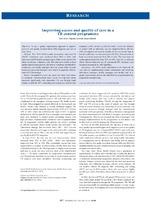Is there room for improvement? Intervening at facility and district level to improve access and quality of care in a well-performing TB Control Programme: the Cape Town experience

View/
Date
2012Author
Scott, Vera
Caldwell, Judy
Azevedo, Virginia
Metadata
Show full item recordAbstract
Objectives. To use a quality improvement approach to improve
access to and quality of tuberculosis (TB) diagnosis and care in
Cape Town.
Methods. Five HIV/AIDS/sexually transmitted infections/TB
(HAST) evaluations were conducted from 2008 to 2010, with
interviews with 99 facility managers and a folder review of over 850
client records per evaluation cycle. The data were used in a local
quality improvement process: sub-district workshops identified key
weaknesses and facility managers drew up action plans. Lessons
learnt and successful strategies were shared at quarterly districtwide
HIV/TB meetings.
Results. Geographical access was good, but there were delays
in treatment commencement times. Access for high-risk clients
improved significantly with intensified TB case finding made
routine in both the HIV counselling and testing and antiretroviral
treatment (ART) services (p<0.01 for both). Access for children
in contact with an infectious case has improved but is still low
(42% investigated and treated). Quality of care was mostly high at
baseline (adherence to treatment protocols 95%). Measurement of
body mass index improved from 20% to 62%. The assessment of
contraception improved from 27% to 58%. Care for co-infected
clients showed improved use of customised HIV stationery and
increased assessment for ART eligibility.
Conclusions. The HAST audit contributed to the improved TB
cure rates by supplementing routine information and involving
sub-district managers, facility managers and facility staff in a
quality improvement process that identified local opportunities for
programme strengthening.
